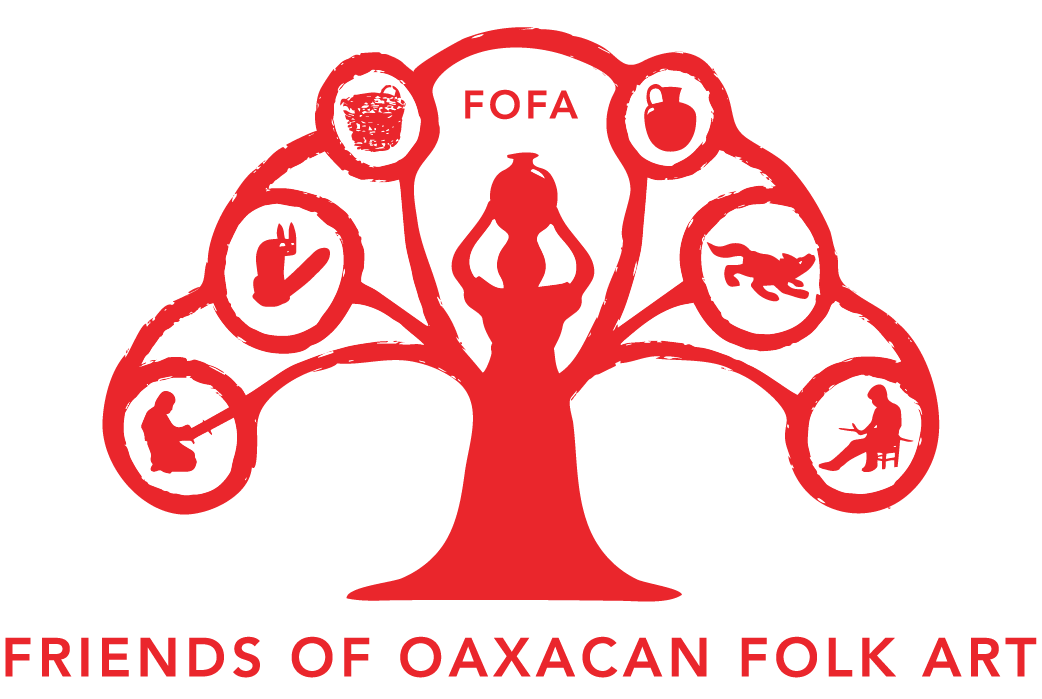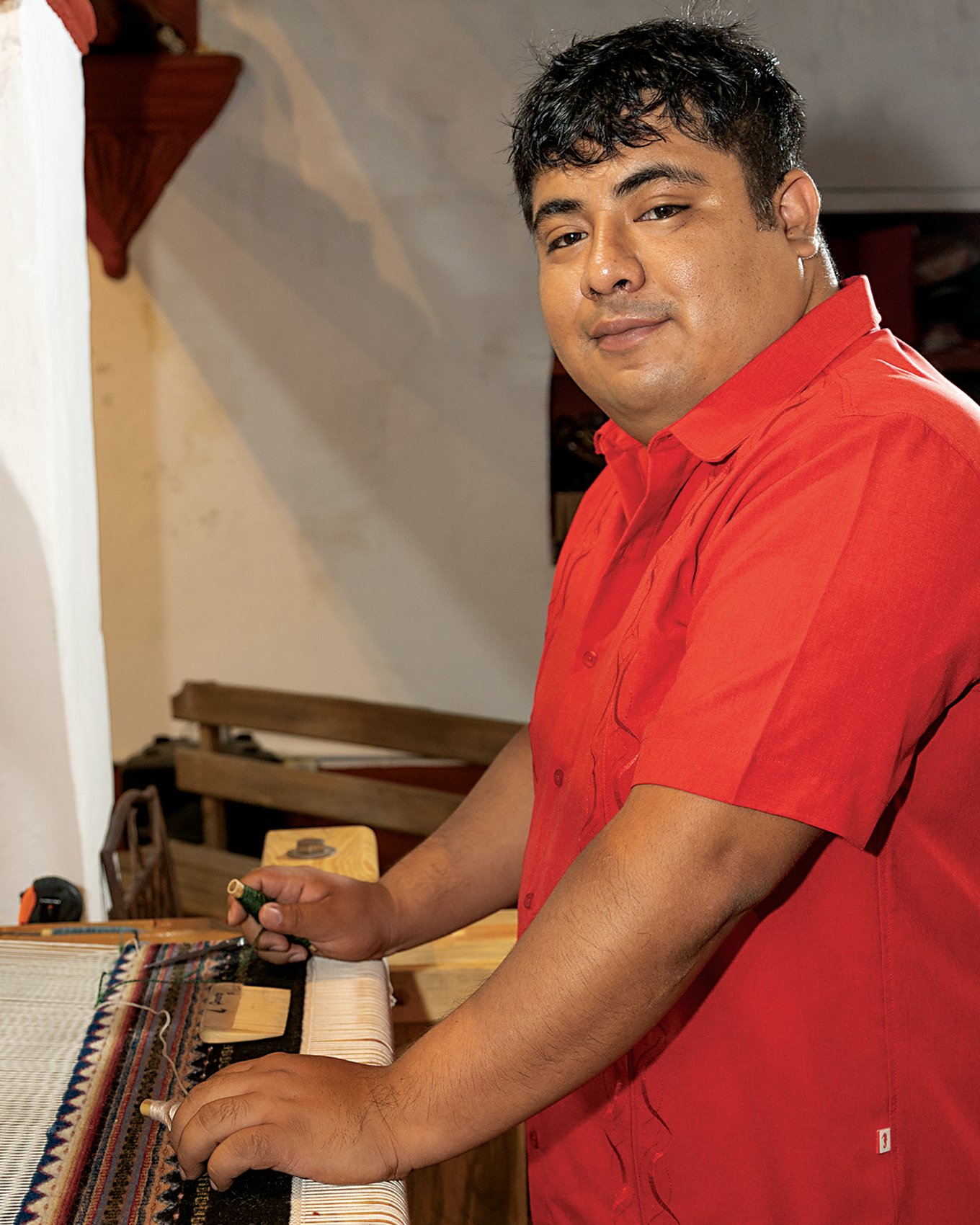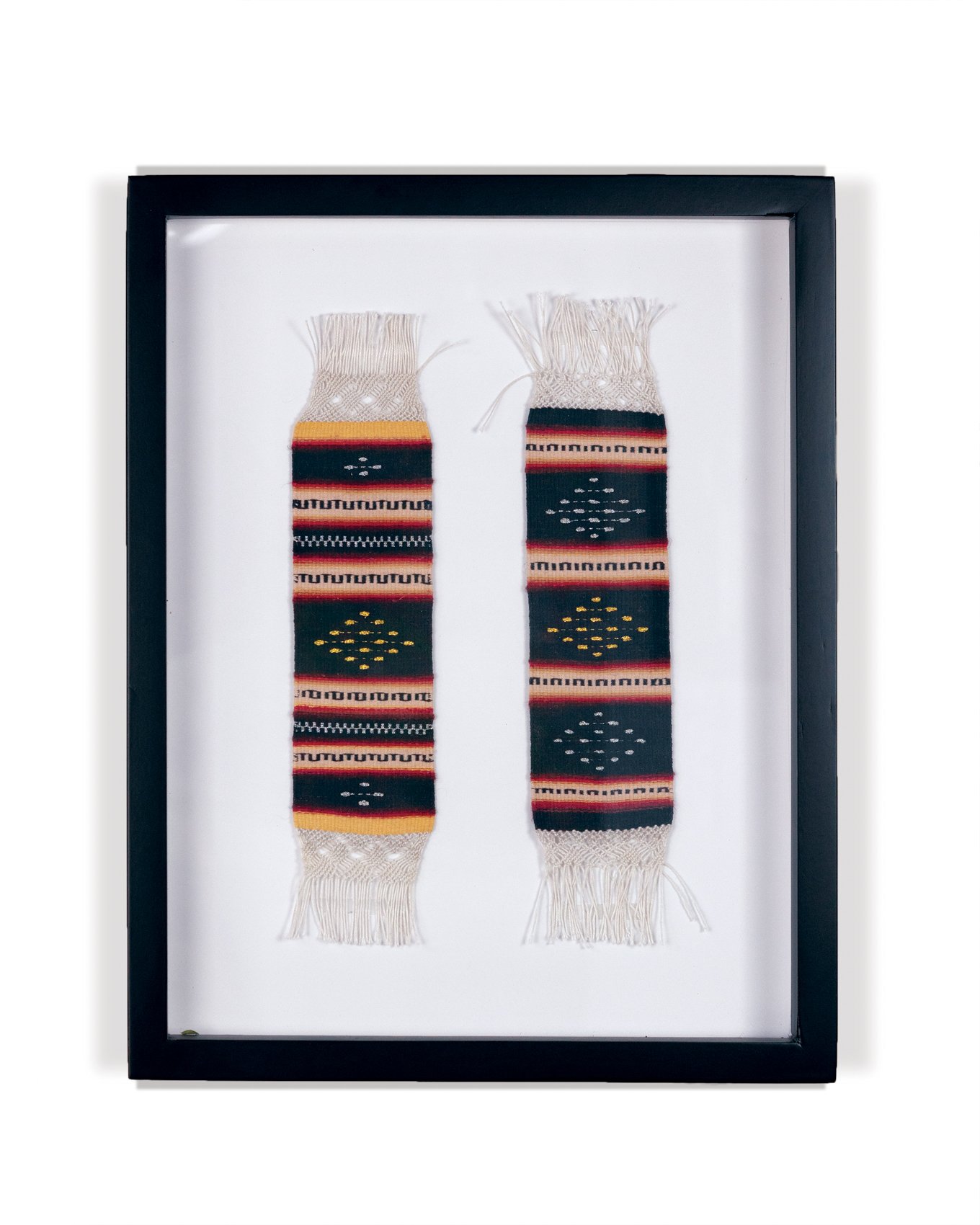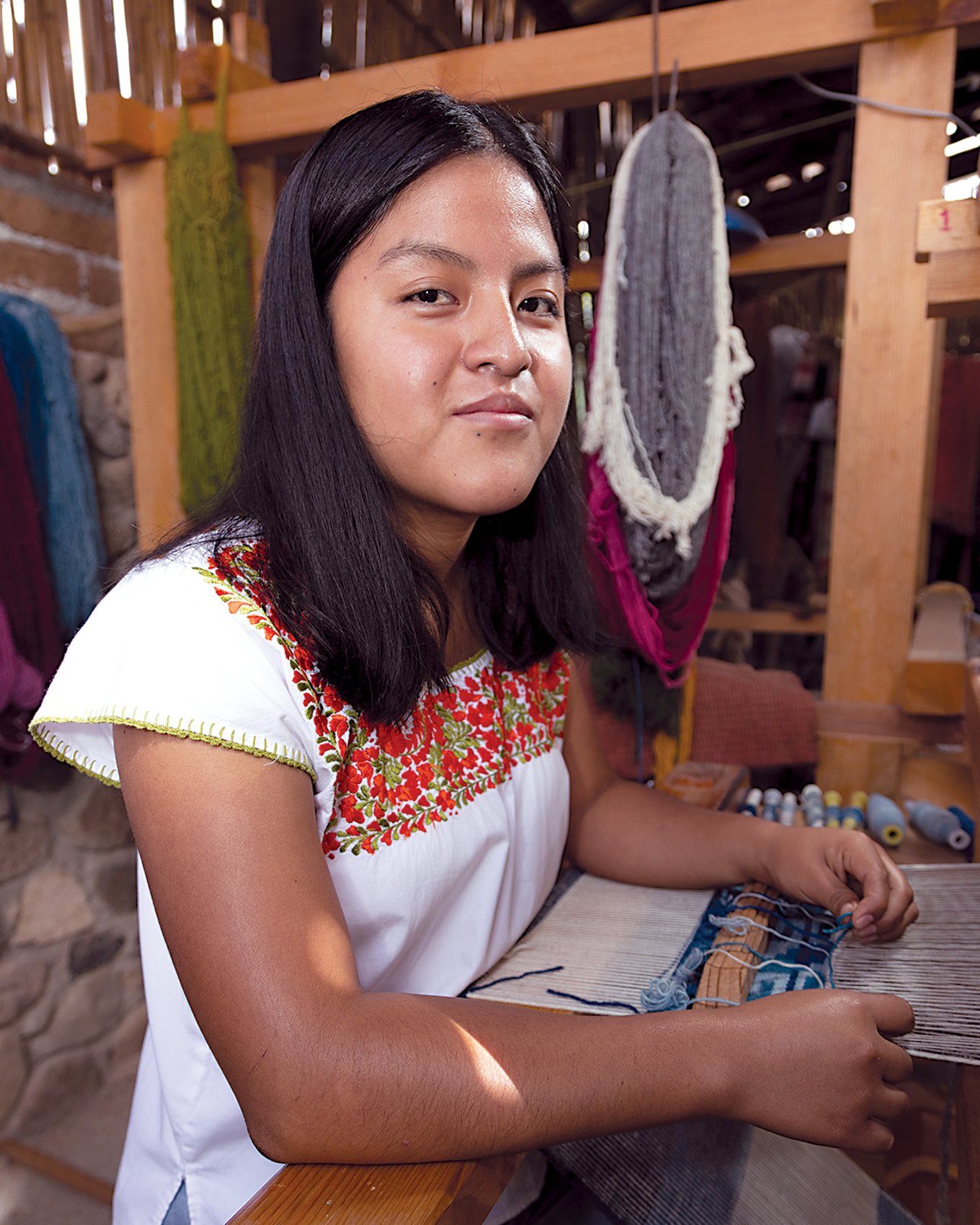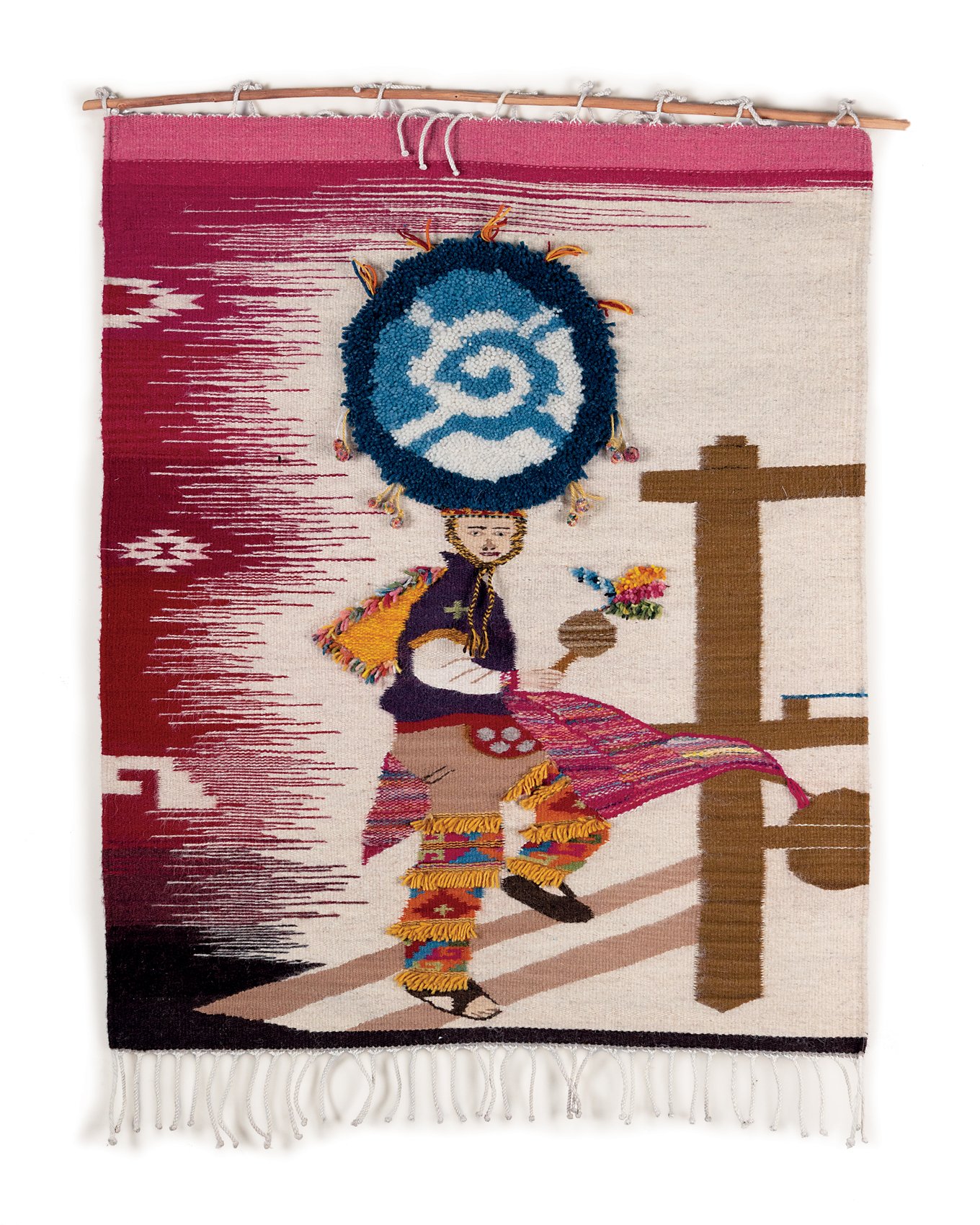MEET THE ARTISTS
SHUTTLE LOOM WOVEN WOOLEN RUGS & WALLHANGINGS
Oaxaca is renowned for its wealth of textiles. In addition to the textiles found in Oaxaca City and its surrounding pueblos, many wonderful varieties come from distant regions of the state that far exceed our geographical radius. However, they can be seen in the markets and better folk art shops of Oaxaca City.
Oaxaca’s textiles can be divided into two broad categories: weaving and embroidery. Weaving includes woolen rugs and wall hangings created on shuttle looms; cotton belts, handbags and placemats produced on backstrap looms; and cotton and silk cloth made on foot pedal-operated shuttle looms. The latter are either sold as yard goods or used to make finished bedspreads, tablecloths, dresses, huipiles (blouses) and shawls. Embroidery consists primarily of hand-made garments called “wedding dresses.” Textile patterns derive from many sources, including Oaxaca’s famous archaeological sites of Mitla and Monte Albán. Others reflect the more specific heritage of an individual family’s creative work.
Some types of weaving are created in specific pueblos and others can be found in more than one pueblo. Woolen rugs and wall hangings are woven on shuttle looms in Teotitlán del Valle and neighboring Santa Ana del Valle. Backstrap loom belts, handbags and placemats are created in Santo Tomás Jalieza. Cotton cloth is produced in both the Xochimilco section of Oaxaca City and the pueblo of Mitla. Blouses, dresses and shawls (rebozos) are specialties of Mitla. Embroidered blouses and dresses are created in San Antonino Castillo Velasco and neighboring San Juan Chilateca.
Shuttle Loom Woolen Rugs and Wall Hangings
There may be as many as 150 weaving families in Teotitlán del Valle and Santa Ana del Valle. They vary greatly in quality and style. The finest work is carried out by a far smaller number of families who create dyes from natural substances and use pure hand-spun wool. Nearly all of them work on shuttle looms operated with foot pedals and treadles, dating back to the 16th century when they were introduced by the Spaniards. This is in contrast to the vast majority of families using chemical dyes and acrylic fibers introduced in the 1920s. These can be produced and processed far more rapidly and are less costly.
Santa Ana del Valle
Alberto (Bëërt) Sánchez Martínez
[3rd Place in Shuttle Loom Woven Rugs, FOFA’s 2018 contest; Honorable Mention in Shuttle Loom Woven Rugs, FOFA’s 2022 contest; Honorable Mention in Textiles, FOFA’s 2008, 2011, 2013, 2016 contests]
Calle Hidalgo s/n, Carretera Principal, Santa Ana del Valle 70428
(To call from US, first dial 011-52)
Tel celular • Cell phone: 951-194-1624
Email: albertsac.2906@gmail.com
Facebook: Bëërt Gallery/Studio
Instagram: beert_sanchez
Alberto, who began weaving at 13 years of age, hopes to be appreciated as an innovative, talented, and patient artist. An engineer by training, he says that “my scientific knowledge helps me to interpret nature, and inspires me to produce art.” He hopes his art conveys his respect for nature and inspires others to feel the same. The evocative layers of earth, sea and sky in Alberto’s tapestry are modeled on oil painting. He creates an unusual texture by incorporating clumps of pilled wool, detritus that is usually removed and discarded during the weaving process. He likens the impact of this technique to the dense application of oil paint on a canvas. Alberto comes from a weaving family that goes back generations. He teaches weaving classes to adults at the Textile Museum in Oaxaca City.
Teotitlán del Valle
Hilario Chávez Sosa
[Honorable mention in textiles, FOFA’s 2008. 2011]
Pueblo of Teotitlán del Valle
Antonio de León #14
(From US) Cell: 011-52-951-103-7397
(In Oaxaca) Cell: 951-103-7397
For Hilario, a member of a weaving family, textiles are a fundamental part of his life. This rug was inspired by the Nahuatl Codice, a mythology in which his ancestors adopted animals as their gods. Impressed by their stories, he decided to illustrate a person turning into a snake. Although he basically followed the original image, tracing it on the warp of his loom, he modified the colors according to his own tastes and added a fret pattern found on the church in his local community. Hilario decided to use 16 threads per inch, finer than is his family’s custom, to enable him to incorporate more detail into his piece.
Fidel Cruz Lazo
Pueblo of Teotitlán del Valle
Avenida Juárez #190
casacruz2000@hotmail.com
(From US) Landline: 011-52-951-524-4020
(In Oaxaca) Landline: 524-4020
Fidel and his wife, María Luis Mendoza de Cruz, have developed a vibrant and exotic array of natural dye colors and distinctive designs. They take pride in never using the same exact design twice, and in discovering and producing new substances with which to create additional colors. Their most exotic colors are tones of turquoise, red and blue. Everything about Fidel and María’s work is creative and first-rate, down to the unusually meticulous way in which their fringes are finished. They sign their pieces and guarantee their originality, durability and color fastness. Most of their designs are in the Zapotec tradition, for example, a diamond is not simply a diamond, but one that incorporates a symbol indicating that life continues.
The González Pérez Family
María Luisa González Pérez
[Honorable mention in textiles, FOFA’s 2008 contest]
Pueblo of Teotitlán del Valle
Avenida Juárez #93
casagonzalezperez@hotmail.com
(From US) Landline: 011-52-951-166-6236
Cell: 011-52-951-121-8713
(In Oaxaca) Landline: 166-6236
Cell: 951-121-8713
María Luisa’s tapestry, “Woman Making Tejate,” is an homage to her grandmother inspired by a family picture. In the past the women of Teotitlán del Valle did the domestic work, while men made the beautiful rugs for which this pueblo is renowned. The process of creating a tapestry is long and labor-intensive. María Luisa told FOFA that she hopes that people will appreciate this rug, dominated by reds and browns, since it was made not only with woolen thread but also with a great deal of faith and dedication. Through her work the young weaver hopes to transmit and preserve her culture.
Mario Porfirio González Pérez
[Honorable mention in textiles, FOFA’s 2016, 2018 contests]
Pueblo of Teotitlán del Valle
4a Sección Avenida Juarez #149
gonzalezperezmario39@gmail.com
(From US) Landline: 011-52-951-166-6236
Cell: 011-52-951-298-9164
(In Oaxaca) Landline: 166-6236
Cell: 951-298-9164
Mario combines the Zapotec symbols that have been in his family with a design based on maize, or corn. This is because he finds the ancient legend of corn-made men inspiring, and maize is extremely important within his community. With this rug, he conveys the message that "the original maize should not die because of the use of genetically modified corn." The 2016 FOFA contest theme – honoring roots and exploring dreams - stimulated him to use his family’s design and pure wool without dye. Mario began spinning wool at age ten and weaving rugs at twelve, learning from both his mother and father. He would like to create modern designs, while retaining his parents’ technique and materials.
Gabriel Gerard Mendoza Gagnier
[Honorable Mention in in Shuttle Loom Woven Rugs, FOFA’s 2022 Contest]
Macedonio Alcalá #203, Oaxaca de Juárez 68000
Cell phone: (From US) 011-52-951-156-4434
(In Oaxaca) 951-156-4434
Landline: (From US) 011-52-951-516-4275
(In Oaxaca) 516-4275
Email: galeriamanomagica@gmail.com
Instagram: arnulfo_mendoza_taller
Gabriel started weaving at the age of 13, learning from his renowned father, Arnulfo Mendoza, and several uncles who taught him to weave small, delicate, fine pieces. He stopped weaving when his father died but resumed four years ago with a new spirit of experimentation. During the pandemic, he sought to combine tradition, quality, and fine materials, while creating more affordable pieces. Knowing that it is just as difficult to make small pieces as large ones, he simplified the designs using pointillism with gold and silver threads so that people today can access fine rugs, but now in miniature.
Nereo Gutiérrez Ruíz
[Honorable mention in textiles, FOFA’s 2016, 2018 contest]
Pueblo of Teotitlán del Valle
Avenida Juárez #11
(From US) Cell: 011-52-951-570-8267
(In Oaxaca) Cell: 951-570-8267
Nereo’s father, from whom he learned to weave, encouraged him to enter FOFA’s 2016 contest. His piece “Grecas from the Temple of Teotitlán” is an homage to the creations of his forefathers, who carved the same greca design on large boulders found in the earth. Nereo chose natural colors similar to those of the early rock patterns. Although today he and his father work for textile wholesalers in order to make ends meet, his great desire is to work with his father to transfer his drawings onto the loom. He would like to achieve some renown by displaying and selling their collaborative pieces.
The Lazo Gutiérrez Family
Ricardo Nabor Lazo Gutiérrez
[Honorable Mention in Shuttle Loom Woven Rugs, FOFA’s 2022 contest; Honorable Mention in Textiles, FOFA’s 2011, 2013 contests]
Labastida #3, Teotitlán del Valle 70420
(To call from US, first dial 011-52)
Tel celular • Cell phone: 951-495-1298
Tel de casa • Landline: 951-524-4466
Email: lazogtz@gmail.com
Instagram: niviet_ru_zaa
Ricardo lives in a family weaving compound going back at least six generations in which every one of his ancestors was a weaver. He began weaving at eight years of age when his father taught him how to pass the shuttle in a zigzag manner, using a chair for a loom. Ricardo’s grandfather created a book mapping the Zapotec relief carvings found on the walls, friezes, and tombs at the nearby Mitla ruins, which Ricardo and his brothers study carefully. In his two-sided weaving Ricardo portrays the process an artist goes through when facing uncertainty, “taking refuge in art” to cope, which “helps us find new perspectives.” On one side shadows and clouds obscure our perceptions. The artist’s clarity, representing for each of us the promise of a new dawn, is revealed with traditional Zapotec grifa designs on the reverse side. Ricardo is writing his master’s thesis in biology on the role of bacterial fermentation in the setting of natural dyes. His family has woven and dyed wool for at least five generations.
Juan Eleuterio Lazo Gutiérrez
[1st Place in Shuttle Loom Woven Rugs, FOFA’s 2022 Contest; Honorable Mention in Textiles, FOFA’s 2011, 2016 Contests]
Labastida #3, Teotitlán del Valle 70420
(To call from US, first dial 011-52)
Tel celular • Cell phone: 951-325-9386
Tel de casa • Landline: 951-524-4466
Email: lazogutierrez481@gmail.com
Instagram: niviet_ru_zaa
Juan’s family has a long lineage as weavers.. His tapete symbolizes his belief that we are in a constant state of creating ourselves. We freshly weave ourselves from our family and cultural influences, represented by the traditional indigo Zapotec design. A self-portrait, above Juan’s shoulder is a brown ceramic jar, representing his grandmother. The wool skeins obscure part of the tapestry, just as part of the weaver is hidden from the observer who cannot know the family and cultural influences which guide the weaver’s decisions. Overarching this, Juan explains, "the sun represents the different days a person lives; each color represents a day, and each generation has different suns and different colors."
Rolando Lazo Mendoza
[Honorable mention in textiles, FOFA’s 2011 contest]
Pueblo of Teotitlán del Valle
Avenida Juárez #30
rolando92lm@hotmail.com
(From US) Cell: 011-52-951-272-4506
(In Oaxaca) Cell: 951-272-4506
Rolando started helping his uncles to comb and skein of wool at the age of eight. Later he began making his own designs, simple ones at first, but always with a desire to create rugs that were finer and more complex. In this weaving he created a very detailed design composed of separated greca frets and an elaborate diamond-shaped figure in the center. After completing his initial drawing, he feared it would be too difficult to execute, but ultimately he succeeded with great pride.
Constantino Lazo Martínez
[1st prize in “Tapetes,” FOFA’s 2018 contest]
Pueblo of Teotitlán del Valle
Matamoros #13 Sección Segunda
constantine1941@hotmail.com
(US) Cell: 011-52-951-342-9723
(In Oaxaca) Cell: 951-342-9723
Constantino’s weaving depicts a pregnant Zapotec woman whose eyes are closed as she imagines her son or daughter and dreams about what she will teach this child. She envisions a beautiful future, hinted at by a gold earring on one side of the tapestry, because the child draws strength from its rich Zapotec heritage. Constantino uses a traditional, but now rare, weaving technique called “double vision,” in which both sides of the tapestry are equally carefully finished. His mother originally taught him to weave, and this difficult technique was taught to him by the master Oaxacan weaver, Fausto Contreras.
The Maldonado Martínez Family
Carol Danae Maldonado Martínez
[Honorable Mention in Shuttle Loom Woven Rugs, FOFA’s 2022 Contest]
Avenida Juárez #198, Teotitlán del Valle 70420
(To call from US, first dial 011-52)
Cell phone: (From US) 011-52-951-260-0529
(In Oaxaca) 951-260-0529
Landline: (From US) 011-52-951-166-6172
(In Oaxaca) 166-6172
Email: eltonodelacochinilla@gmail.com
Facebook: El Tono De La Cochinilla
Instagram: eltonodelacochinilla
In weaving this rug, she honors her great grandfather, the renowned (late) Isaac Vásquez who revived the use of natural dyes in their pueblo. Carol is a member of the fifth generation of weavers in her family, having begun at twelve years of age. She particularly enjoys thinking of new ideas and learning new techniques. Carol believes that dances and color inspire hope, especially the feather dance which she has featured in her rug. She used a new three-dimensional technique; short pieces of wool stick out from the rug, instead of feathers in the dancer’s headdress. For Carol, dancers are powerful promoters of traditional culture.
Kim Eduardo Maldonado Martínez
[Honorable mention in “Tapetes,” in FOFA’s 2018 contest]
Pueblo of Teotitlán del Valle
Avenida Benito Juárez #198
eltonodelacochinilla@gmail.com
(From US) Landline: 011-52-951-166-6172
Cell: 011-52-951-260-0529
(In Oaxaca) Landline: 166-6172
Cell: 951-260-0529
Kim Eduardo comes from a family of distinguished rug weavers, including his grandfather, the renowned Isaac Vásquez. Kim’s naturally dyed tapestry is a tribute to his Zapotec ancestors. Legend has it that Quetzalcoatl came down to Picacho, the mountain in the background that overlooks Teotitlán, providing a sign that Kim’s nomadic ancestors should establish roots there. The greca pattern along the rug’s bottom represents their Zapotec foundation, and the central three figures represent the many generations who have given strength to Kim’s people today. Also present are the three basics of Zapotec diet—beans, squash, and corn—which are planted together, because these crops help each other to grow and then nourish the Zapotec people.
Isaac Armando Martínez Lazo
[Winner in textiles, FOFA’s 2008 contest; Honorable mention in textiles, FOFA’s 2011, 2013, 2016, 2018 contests]
Pueblo of Teotitlán del Valle
Aquiles Serdan #30
natural_musgo@hotmail.com
(From US) Landline: 011-52-951-166-6169
(In Oaxaca) Landline: 166-6169
Isaac is a third generation weaver, following his father and paternal grandfather, who began experimenting with designs when he was nine years old. In this intricate weaving Isaac uses three distinct panels to tell his story. The wool is hand woven and hand dyed using natural indigo and cochineal, techniques that he learned from his father and his grandfather. The lower panel displays traditional geometric motifs of Mitla to represent the underworld. The designs on the left panel symbolize Isaac’s Zapotec culture and origins. On the right, one of his ancestors looks out over the farmland and mountains of the Oaxaca valley to the sky. The night sky reveals the passing of time, measured in the phases of the moon and the path of the sun.
Guillermo Martínez Lorenzo
[Honorable mention in textiles, FOFA’s 2016 contest]
Pueblo of Teotitlán del Valle
Progreso #7
(From US) Landline: 011-52-951-524-4003
Cell: 011-52-987-111-2671
(In Oaxaca) Landline: 524-4003
Cell: 987-111-2671
The sun setting behind the Oaxacan mountains is a familiar sight to Guillermo, who works long days in the fields of his village. In this intensely colorful tapestry, the light of the ancient sun illuminates the present. The grecas (traditional geometric motifs) in the red sky reveal the movement of the wind and represent Guillermo’s Zapotec roots, which he is determined must never be lost. This piece captures the transitional moment between the death of the day and birth of the night, and exemplifies the moment in time when we exist between the past and the future.
Justino Martínez Mendoza
[Honorable mention in textiles, FOFA’s 2011 contest]
Pueblo of Teotitlán del Valle
Fiallo #31
(From US) Landline: 011-52-951-524-4333
Cell: 011-52-951-298-6612
(In Oaxaca) Landline: 524-4333
Cell: 951-298-6612
Justino feels it is very important to live in the present, while also remembering the past. With humor he recalled that, even though his parents scolded him when he was little, he has always liked to incorporate new elements into his pieces. “I like to imagine how life was before, when natural resources were protected and people helped maintain nature’s balance.” He decided to use the natural tones of wool and, after completing the weaving, he combed the wool to give it more texture and to restore its original softness.
Leonardo Daniel Martínez Mendoza
[Honorable mention in Shuttle Loom Woven Rugs, FOFA’s 2018, 2022 contests]
Francisco Javier Mina s/n, Teotitlán del Valle 70420
(To call from US, first dial 011-52)
Tel celular • Cell phone: 951-135-2472
Email: danielmendozacontreras3@gmail.com
Facebook: Leonardo Daniel
Instagram: leo_martinez_00
Leonardo is a painter who began to weave four years ago. His painter’s eye is reflected in the bright colors he creates for his weaving. He prepares his natural dyes using techniques he learned in a chemistry course. The history of all Teotitlán is conveyed with his designs. The symbol of life (greca) represents the Zapotec people, and corn represents peasant life. The fist that dominates the rug communicates the physical force required to weave. It grips the woven rug, daily life for the artists of Teotitlán, which becomes the feathered serpent—the god Quetzalcoatl—that represents art: the transformation of the natural to the supernatural.
José Mendoza Martínez
[Winner in textiles, FOFA’s 2011 contest; Honorable mention, FOFA’s 2008, 2013 contests]
Pueblo of Teotitlán del Valle
Alvaro Obregon #3
textilesjm@gmail.com
(From US) Landline: 011-52-951-524-4341
Cell: 011-52-951-111-2377
(In Oaxaca) Landline: 524-4341
Cell: 951-111-2377
For José weaving is an inspiring language that deserves more attention in the world of art. He observes that while painting is done on top of a canvas, weaving creates the surface itself as the artist creates the image. In this piece José experimented with the number four, his guiding number, which is also cosmologically very powerful. Numbers are hidden under colors, demonstrating the vibrant music of weaving. He added glyphs, or symbols, that represent breath and the cycle of life. José dyed the wool in a free manner, creating spontaneous colors from four natural substances. To preserve the land and its resources, he makes his rugs using only organic fibers and natural dyes, including the purple snail.
The Mendoza Ruiz Family
Christián Mendoza Ruíz
[2nd Place in Shuttle Loom Woven Rugs, FOFA’s 2022 contest; Honorable Mention in Textiles in FOFA’s 2013 contest]
20 de noviembre #17, Teotitlán del Valle 70420
(To call from US, first dial 011-52)
Tel celular • Cell phone: 951-178-7752
Tel de casa • Landline: 951-524-4282
Email: christian.99mendoza@gmail.com
Facebook: christianmendozaruiz
Instagram: christianmendozaruiz
The complex, symmetrical patterns woven into "Diamantes" far exceed one’s expectations of a young man. Cristián learned his technique from his parents, who also taught him to dye wool using tree bark, moss, cochineal (cactus insects), indigo, and flowers. He says that diamonds are symbolic of stars, and the dark background represents the night sky. His even stitch and balanced designs are matched in depth by his passion for his art. Although his family cannot say for certain, they speculate that at least eight generations of weavers stand behind Cristián.
Jacobo Mendoza Ruíz
Pueblo of Teotitlán del Valle
Avenida Juárez #91
jacobom3@yahoo.com.mx
(From US) Landline: 011-52-951-524-4157
Cell: 011-52-951-318-0368
(In Oaxaca) Landline: 524-4157
Cell: 951-318-0368
Jacobo, a master weaver featured in the exhibition FOFA sponsored following its 2008 young artists’ competition, is known for the fine quality of his work. He finishes the tassels of his rug in a very original and elaborate way that contrasts with the geometric figures that define “Diamond Scale.” He notes that this work is executed in equal parts. In creating it, he mastered a geometric unity that reflects the harmony and tranquility of life in his pueblo. The idea of producing this rug was inspired by Jacobo’s experience working with artisans outside Mexico who taught him new techniques for perfecting his weaving, which is his passion.
Jacobo Mendoza Vásquez [son of Jacobo Mendoza Ruiz]
[3rd Place in Shuttle Loom Woven Rugs, FOFA’s 2022 contest; Honorable Mention in Shuttle Loom Woven Rugs, FOFA’s 2018 contest]
Avenida Juárez #91, Teotitlán del Valle 70420
(To call from US, first dial 011-52)
Tel celular • Cell phone: 951-400-6081
Tel de casa • Landline: 951-524-4157
Email: jacobomendoza298@gmail.com
Facebook: Jacobo Mendoza
Instagram: jacobo_mendozaweaver
When Jacobo heard the 2018 competition theme -- “showing the strength of my people” -- he sought to create a design that weaves together his heritage and his imagination. At the center is the sun, the radiant source of abundant life in his valley of Teotitlán, that nurtures the surrounding mountains, flowers, and plants. He incorporated traditional geometric grecas, symbolizing his people. His fine weaving technique, taught to him by his father, utilizes 20 threads to the inch rather than the traditional eight. Jacobo’s choice of uncommon materials – he mixes alpaca, merino, silk, and silk threads dipped in gold (from Japan) -- gives this rendering of his culture the resplendent quality he sought.
The Mendoza Sosa Family
Abner Yair Mendoza Sosa
[2nd prize in tapetes, FOFA’s 2018 contest; Honorable mention in textiles, FOFA’s 2013 contest]
Pueblo of Teotitlán del Valle
Prolongación Buena Vista #53
mendozarte@gmail.com
(From US) Landline: 011-52-951-524-4638
Cell: 011-52-951-344-0049
(In Oaxaca) Landline: 524-4638
Cell: 951-344-0049
Abner was 12 when he created this style – a miniature, with 26 threads per inch - that would tax most accomplished adults. His father, a master weaver, explained that Abner could not wait to enter FOFA’s young artists’ competition, his first, and had to take turns with his sister, Diana, for time on their shared loom. His four tiny creations, representing the four seasons, contain a huge world in which he portrays elements of earth, air, and energy. His intricate weavings, based on traditional Zapotec designs, merit close inspection.
Diana Melisa Mendoza Sosa
[Honorable mention in textiles, FOFA’s 2013, 2018 contests]
Pueblo of Teotitlán del Valle
Prolongación Buena Vista #53
diamel@gmail.com
(From US) Landline: 011-52-951-524-4638
Cell: 011-52-951-344-0048
(In Oaxaca) Landline: 524-4638
Cell: 951-344-0048
Diana’s deep red “Flower of Oaxaca” boasts eighteen carefully wrought petals. This traditional design is richly invested with multiple meanings. The flower, she explains, refers to the union and productivity of man and woman; it also represents the repetitive cycle of day and night and the eighteen months of an ancient calendar. The twenty lines along each side of the image stand for the twenty days of each month. The big challenge of this project for its weaver was technical: managing the petals’ curves. “I tried something new,” she says, “and I triumphed.”
Bulmaro Pérez Mendoza
Pueblo of Teotitlán del Valle
Centenario #27
oramlub@prodigy.net.mx
(From US) Landline: 011-52-951-524-4011
Cell: 011-52-951-151-4103
(In Oaxaca) Landline: 524-4011
Cell: 951-151-4103
Bulmaro is one of Teotitlán’s best weavers, blending devotion to the preservation of tradition with a forward-looking, enterprising spirit. Bulmaro and his family take great pride in their tradition of natural dyes and pure wool. His signature combination is greens, mustard, browns, turquoises and oranges. He has also created unique semi-abstract designs that he entitles montañitas (little mountains) and símbolo de la lluvia (symbol of the rain). In the late 1990s he introduced a different fiber, mohair, which he believes to be considerably more durable, lasting at least 80 or even 100 years, depending upon the uses to which it is put.
Fermina Ruíz Gutiérrez
[Honorable mention in textiles, FOFA’s 2008 contest]
Pueblo of Teotitlán del Valle
20 de noviembre #17
lachomendoza@hotmail.com
(From US) Landline: 011-52-951-524-4282
(In Oaxaca) Landline: 524-4282
The pattern of Fermina’s rug, “Jaguar Playing Ball Game,” was designed by her husband, Horacio Mendoza. In ancient Zapotec culture, the jaguar represented power; for this reason it was incorporated into the masks worn in battle by outstanding warriors. The ancient ball games are believed to have been bloody games of life and death in which the loser was sacrificed to the gods. These players are depicted in wool in colors produced with natural dyes: the red of cochinea (derived from insects living in cacti), representing the new dawn; the yellow of moss, standing for knowledge and power; and the black of the pomegranate symbolizing darkness.
The Vásquez Family
Pueblo of Teotitlán del Valle
(The late) Isaac Vásquez García and Gerónimo Vásquez Gutiérrez (his son)
Pueblo of Teotitlán del Valle
Hildalgo #30
finerugs30@gmail.com
(From US) Landline:
011-52-951-524-4122
Cell: 011-52-951-218-1215
(In Oaxaca) Landline: 524-4122
Cell: 951-218-1215
Isaac, the eldest living member of a well-known weaving family in Teotitlán del Valle, pioneered the renaissance of pre-Hispanic Zapotec and Mixtec natural dyes and the use of pure wool that better absorbs these colors. Isaac and his three sons and five daughters and their families all take great pride in following these techniques, despite the time-consuming and expensive nature of these methods when compared with chemical dyes and acrylic fiber. Isaac’s signature designs derive from ancient sources. He creates estelas (figures seen in stone carvings in the majestic Oaxacan ruins of Monte Albán) and codices (manuscripts) also from Monte Albán. These styles have been copied by many of his fellow villagers, but he was the artist who introduced them. Isaac weaves in a wide range of other styles, including patterns from pre-historic cave paintings, reproductions of Diego Rivera paintings, and geometric stepped fret patterns from Mitla. His son Gerónimo lives and weaves in the same workshop.
Ernesto Vásquez Gutiérrez (son of Isaac)
Avenida Juarez # 138
vasqueztapetes@yahoo.com.mx
(From US) Landline: 011-52-951-524-4144
Cell: 011-52-951-107-9705
(In Oaxaca) Landline: 524-4144
Cell: 951-107-9705
Ernesto, Isaac’s eldest son, creates a wide variety of shuttle loom woven rugs of extremely high quality all with natural dyes. They range from pre-Hispanic designs and traditional patterns that incorporate the Zapotec elements displayed at the archaeological site of Mitla to modern representational designs such as birds to reproductions inspired by artists such as Escher, Matisse and Rivera. Once a pattern is designed, a model is produced thread by thread. It is subsequently recorded on paper, including the colors that will be used to make a particular rug or wall hanging. Then the loom is strung and the process of shuttle weaving begins.
